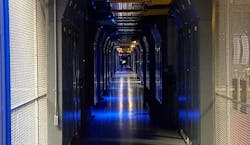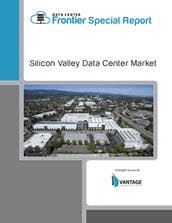Pre-Leasing Drives New Supply in Santa Clara Data Center Market
We continue our series of stories on the leading geographic markets for data center space. Data Center Frontier is partnering with DatacenterHawk to provide in-depth market reports on each city we profile.
As we noted in part one, Silicon Valley remains one of America’s busiest markets for data center space, and is home to nearly 2.6 million square feet of mission-critical space. Today we examine supply and demand in this key market, and what to expect over the coming year.
In recent months Santa Clara has seen a historic flurry of large leases:
- In early 2016, a single tenant pre-leased 16 MW of space from DuPont Fabros Technology, accounting for the entire third phase of the company’s data center in Santa Clara.
- In February, CoreSite signed a lease for the entire second phase of its SV7 data center in Santa Clara, representing 9 MW of space.
- Vantage Data Centers recently pre-leased the entire 6 MW V4 data center on its Santa Clara campus.
These deals affirm that Silicon Valley remains a favored destination for hyperscale cloud providers, who are scaling quickly, prompting them to lease wholesale space in Silicon Valley even as they continue to expand their company-built footprints in Oregon and Washington. Speed of deployment is a critical factor for these cloud providers, who are competing fiercely for market share and mindshare.
Data Center Frontier Special Report: The Silicon Valley Data Center Market. Download It Now.
Proximity to San Francisco is also important due to latency and performance factors in cloud service delivery to Bay Area enterprise customers. Working with wholesale providers on large requirements—effectively build-to-suit deals—is often the most efficient way for these companies to meet their capacity needs. Amazon, Microsoft and Apple are all building their own space in the Pacific Northwest while leasing wholesale space in Santa Clara.
Cloud isn’t the only demand driver. Silicon Valley is a market of markets, with strong activity in both retail colocation and wholesale data center space. Tenants use data center space for a variety of purposes, including corporate IT, research labs and high-performance computing, as well as cloud deployments.
Many retail colo customers, including content companies and social media providers, seek interconnections and network-rich data center ecosystems. Equinix is the leading player in this niche, and operates seven data centers in Silicon Valley, including a large data center campus in South San Jose. Digital Realty’s Telx unit also offers interconnection services from multiple facilities in the region.
The high cost of Silicon Valley real estate has recently been creating demand for data center space. Many companies are seeking to move server rooms and technology labs out of their headquarters, as the recent hiring boom has led to a shortage of office space on corporate campuses.
Rows of high-density racks inside Colovore in Santa Clara, which uses water-chilled cooling doors. (Photo: Rich Miller)
This has created several types of opportunities for data center providers. Vantage has done multi-MW deals with several lab tenants for “variable resiliency” space, which support high-density workloads with a non-redundant (N) power configuration. Colovore, which targets high-density customers with colo cabinets featuring water-chilled rear doors, has seen demand from Valley companies whose in-house data centers could not support cloud deployments using converged hardware.
Trends in Supply
There is currently a limited supply of data center space in Silicon Valley, which has prompted several companies to undertake construction projects to bring additional capacity online. These include:
- Vantage recently announced plans to build two new data centers on its Santa Clara campus. The first building, known as V6, is scheduled to come online next year. The total buildout for the two properties will be 21 MW. In addition, Vantage has secured land for a second major data center campus in Santa Clara, which is planned to house an additional 54 MW of IT capacity, with the first building likely to come online in 2018.
- Equinix has broken ground on SV10, a new data center on its South San Jose campus that will be built in three phases, offering 14 MW of capacity at completion. Equinix has plans to build another facility (SV11) on the property as SV10 nears capacity.
- INFOMART has just announced a 6 MW expansion of its campus in San Jose (formerly Fortune Data Centers). The company will retrofit an existing building, and has land available for additional expansion. CoreSite has accelerated its construction schedule for SV7 in Santa Clara, which will bring 123,000 SF of space online later this year and into 2017.
At the close of the second quarter, there was 28 MW of capacity under construction in Silicon Valley, compared to 12.25 MW in the first quarter of 2016, according to datacenterHawk. Although this number has doubled, construction volume in Silicon Valley trails far behind other major U.S. data center markets. Northern Virginia, Dallas/Fort Worth and Chicago all have in excess of 100 MWs of capacity currently under construction.
The DuPont Fabros Technology data center in Santa Clara. (Image: DFT)
Since demand is strong, this appears to reflect the more disciplined approach to new construction in Silicon Valley. That’s probably why wholesale providers have been reporting stronger pricing on their inventory in Silicon Valley. This has been seen most clearly in the public disclosures of return on invested capital for DuPont Fabros, which has risen by about 2 percent between 2013 and 2016.As we noted in our discussion of demand, several recent deals have seen new supply leased up before it is built, prompting new construction announcements. Over the past several years, providers in the Silicon Valley market have been cautious about new construction and disciplined in their deployment of capital, building space in smaller increments. This is reflected in the construction activity in major markets, where Silicon Valley has a lower volume of active projects.
For more on the Silicon Valley market, we invite you to download the Data Center Frontier Special Report: The Silicon Valley Data Center Market.
About the Author




